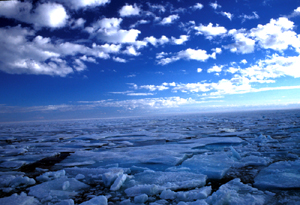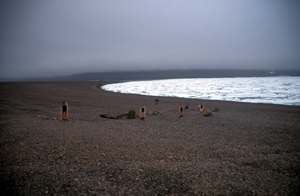|
Exhibition Links
|

View north of King William Island in Larsen Sound, in the area where Sir John Frankkin's ships presumably were trapped in 1846-1848 [photo taken in August 2003]

Graves on Beechey Island: three dating from the Franklin expedition, one from a Franklin search expedition [photo taken in August 2003]
. . . that to have abandoned any further attempt to fulfil an object, which has never ceased to occupy the attention of the British Government since the days of our Elizabeth, and more especially, at this particular time to have left it to be completed by a foreign navy, after the doors of the two extremities of the passage had been thrown open by the ships of our own, would have been little short of an act of national suicide; or, to say the least of it, an egregious piece of national folly. . . . Franklin is now on his voyage, and whether he succeeds in making good the passage or not, nothing, I am most certain, will be wanting on his part, or on that of his gallant comrades, to accomplish all that human means and human intellect can command. [Barrow, Voyages of Discovery, pp. 16, 17.]The Admiralty's instructions to Franklin were fairly simple: Franklin was to proceed westward along Barrow Strait and seek a passage southward between Cape Walker and Banks Land; if that route proved impassable, he should explore a way via Wellington Channel. Franklin's two ships, Erebus (372 tons) and Terror (325 tons), sailed down the Thames on 19 May 1845. (The Terror had been George Back's ship in his expedition of 1836-1837; both ships had recently returned from the Antarctic, under the command of Sir James Clark Ross, who had sought to reach the magnetic South Pole.) Originally built as “bomb vessels” that could absorb the recoil from mortar firing, their stout, wide shape made them good candidates for trafficking in ice, and they had been further modified—with triple-thick sailing canvas, double-thick decks, double-planked hulls, and oak beams fore and aft below—for polar conditions. For Franklin's trip, each had been fitted with a 20-hp steam engine and propeller, to help navigate ice in difficult wind and windless conditions—an innovation for an Arctic vessel.
In early July, in Disko Bay on the west coast of Greenland, the ships took on their last supplies from a transport ship, giving them three years' worth of provisions. Richard Cyriax, historian of the Franklin expedition, has extensively detailed the specifics of these; in his estimate, each ship carried roughly 30 tons of flour, eight tons of beef (in eight-lb. sections), 2500 gallons of concentrated soup, two tons of chocolate, two tons of lemon juice, and more than a ton of tobacco, among many other stores. With the supply ship, some letters were sent home, as well as five men deemed “unfit.” Two English whalers, the Enterprise and Prince of Wales, encountered the expedition on July 28th in Baffin Bay near Lancaster Sound: all was well. From there, the two ships and their crews (a total of 129 men) disappeared from sight.
Anxiety replaced anticipation after the winter of 1846-1847 passed without word from or about the expedition. Urged on by Franklin's indefatigable wife, Lady Jane Franklin, the Admiralty ultimately instigated a three-pronged search effort: by land, down the Mackenzie or Coppermine River to the coast; from the Pacific, via Bering Strait; and from the east, through Lancaster Sound. Lady Franklin also used her personal resources to fund additional efforts, and she persuaded the United States to enter the hunt as well. In all, from 1848 to 1859, thirty-two search expeditions sought the fate of the Franklin expedition. What was found?
Found is a relative term here, for all of the evidence was (and remains) circumstantial. What is known is that Franklin commanded the best-equipped British Navy expedition ever sent into the Arctic, and its disappearance occasioned “a series of relief and search expeditions, both public and private, English and American, which has no parallel in maritime annals, and which, while prosecuting the main object of the voyages, turned the map of the Arctic regions north of America from a blank void into a grim but distinct representation of islands, straits, and seas.” [Dictionary of National Biography entry (1889) for Franklin]
Household Words: A Weekly Journal. London, 1850-1859. Vol. 10. [Rare Books Division: Morris L. Parrish Collection]
Dr. John Rae (1813-1893), a respected explorer and Hudson Bay Company surgeon, was not looking for Franklin during his fourth Arctic expedition of 1853-1854. He was interested in completing the survey of the northern shores of the continent when he petitioned and obtained approval from his employer to proceed with a small party from York Factory on Hudson Bay to Chesterfield Inlet, then overland to George Back's Great Fish River. He wanted to descend the river and then travel northwards again, hoping to determine whether King William's Land was an isthmus to Boothia. Circumstances forced him to change part of his itinerary, but he was able to explore the west side of Boothia Peninsula along what is now called Rae Strait and to determine that King William's Land was actually an island. Returning to Repulse Bay in May 1854, Rae heard stories from local Eskimos (Inuit) about a large number of white men who had died in the spring of 1850 on the west coast of King William Island, and he was able to purchase from them some relics that were obviously related to Franklin's expedition for they bore crests or initials of some of the men. Several bodies had also been found on an island to the northwest of Back's Great Fish River; the information from the natives suggested that the men had been driven to cannibalism.
Rae's report to the Admiralty, in a letter headed “Repulse Bay, July 29, 1854,” was published in The Times the day after his arrival back in London on 22 October 1854. Not surprisingly, a number of Rae's countrymen were offended by his revelation about Franklin's men succumbing to the “last resource.” One of the most eloquent and outspoken critics was the novelist Charles Dickens.
“The Lost Arctic Voyagers.”Thus begins Dickens's two-part rejection of Rae's assertion that Franklin's party had resorted to cannibalism. He questions the reliability of the Eskimos' testimony and cites numerous examples of British explorers in dire circumstances who had not resorted to the “last resource,” including those in Franklin's first overland expedition. Rae provided a rebuttal that was subsequently published in two parts (nos. 248 and 249, 23 and 30 December 1854) under the same title.
Dr. Rae may be considered to have established, by the mute but solemn testimony of the relics he has brought home, that Sir John Franklin and his party are no more. But, there is one passage in his melancholy report, some examination into the probabilities and improbabilities of which, we hope will tend to the consolation of those who take the nearest and dearest interest in the fate of that unfortunate expedition, by leading to the conclusion that there is no reason whatever to believe, that any of its members prolonged their existence by the dreadful expedient of eating the bodies of their dead companions. [Dickens, Household Words, no. 245, 2 December 1854]
Despite the protests of Franklin's widow, the government's reward of £10,000 for discovering the fate of the missing officers and men was finally granted to Rae and his men. But the searching would continue. [see M'Clintock for the end of the story]
Further Papers Relative to the Recent Arctic Expeditions in Search of Sir John Franklin and the Crews of H.M.S. “Erebus” and “Terror”. Presented to Both Houses of Parliament by Command of Her Majesty. January 1855. London, 1855. [General Library Collection]
This summary tome of 958 pages, full of charts, tables, and maps, includes the orders and proceedings of the various relief expeditions, the journals of their numerous sledge journeys, and the telling report of Dr. John Rae. The large accompanying map from the book shows the extent of territory explored by these government-sponsored searching expeditions. Ironically, though nothing of Franklin was found—his tragedy literally took place off the map (to the south, on King William Island)—most of the rest of the Canadian Arctic had been explored and charted in his wake.